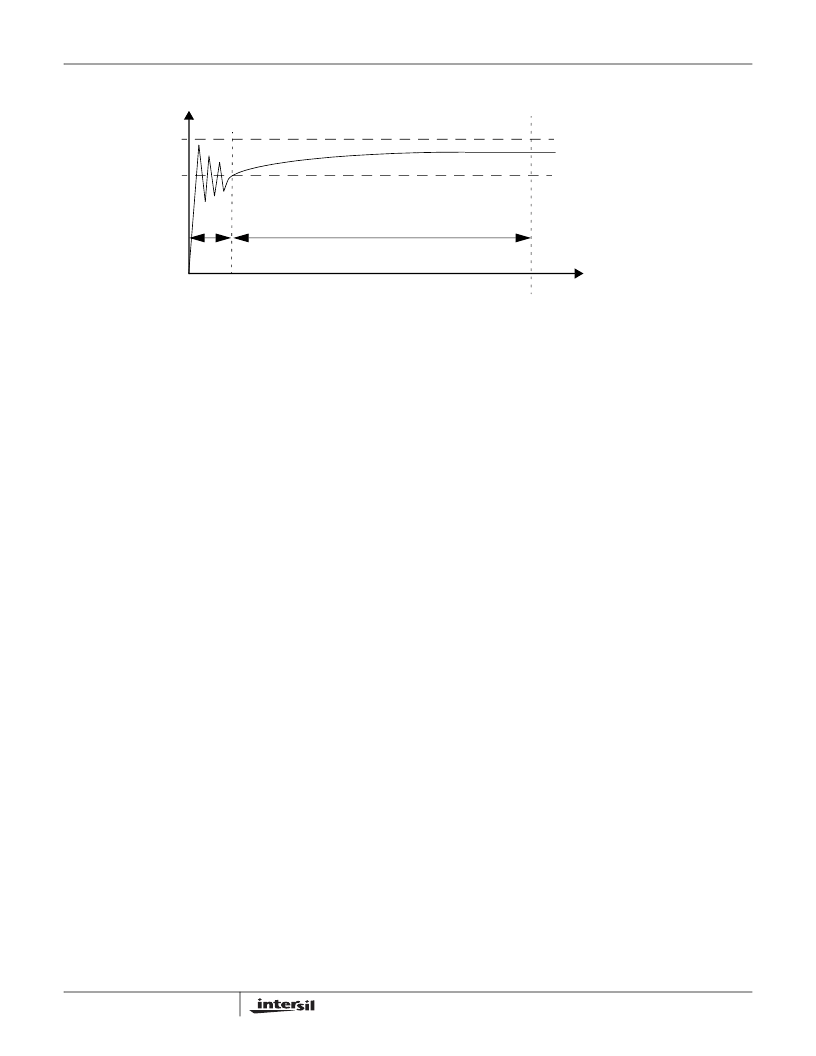- 您現(xiàn)在的位置:買賣IC網(wǎng) > PDF目錄376449 > X9522V20I-B (INTERSIL CORP) Laser Diode Control for Fiber Optic Modules PDF資料下載
參數(shù)資料
| 型號(hào): | X9522V20I-B |
| 廠商: | INTERSIL CORP |
| 元件分類: | 數(shù)字電位計(jì) |
| 英文描述: | Laser Diode Control for Fiber Optic Modules |
| 中文描述: | DIGITAL POTENTIOMETER, PDSO20 |
| 封裝: | PLASTIC, TSSOP-20 |
| 文件頁數(shù): | 7/29頁 |
| 文件大?。?/td> | 486K |
| 代理商: | X9522V20I-B |
第1頁第2頁第3頁第4頁第5頁第6頁當(dāng)前第7頁第8頁第9頁第10頁第11頁第12頁第13頁第14頁第15頁第16頁第17頁第18頁第19頁第20頁第21頁第22頁第23頁第24頁第25頁第26頁第27頁第28頁第29頁

7
FN8208.0
March 10, 2005
The data in the WCR is then decoded to select and
enable one of the respective FET switches. A “make
before break” sequence is used internally for the FET
switches when the wiper is moved from one tap position
to another.
Hot Pluggability
Figure 7 shows a typical waveform that the X9522 might
experience in a Hot Pluggable situation. On power-up,
Vcc / V1 applied to the X9522 may exhibit some amount
of ringing, before it settles to the required value.
The device is designed such that the wiper terminal
(R
Wx
) is recalled to the correct position (as per the last
stored in the DCP NVM), when the voltage applied to
Vcc / V1 exceeds V
TRIP
for a time exceeding t
pu.
Therefore, if
t
trans
is defined as the time taken for Vcc /
V1 to settle above V
TRIP
(Figure 7): then the desired
wiper terminal position is recalled by (a maximum) time:
t
trans
+
t
pu
. It should be noted that
t
trans
is determined by
system hot plug conditions.
DCP Operations
In total there are three operations that can be performed
on any internal DCP structure:
—DCP Nonvolatile Write
—DCP Volatile Write
—DCP Read
A nonvolatile write to a DCP will change the “wiper
position” by simultaneously writing new data to the
associated WCR and NVM. Therefore, the new “wiper
position” setting is recalled into the WCR after Vcc / V1 of
the X9522 is powered down and then powered back up.
A volatile write operation to a DCP however, changes the
“wiper position” by writing new data to the associated
WCR only. The contents of the associated NVM register
remains unchanged. Therefore, when Vcc / V1 to the
device is powered down then back up, the “wiper
position” reverts to that last position written to the DCP
using a nonvolatile write operation.
Both volatile and nonvolatile write operations are
executed using a three byte command sequence: (DCP)
Slave Address Byte, Instruction Byte, followed by a Data
Byte (See Figure 9).
A DCP Read operation allows the user to “read out” the
current “wiper position” of the DCP, as stored in the
associated WCR. This operation is executed using the
Random Address Read command sequence, consisting
of the (DCP) Slave Address Byte followed by an
Instruction Byte and the Slave Address Byte again (Refer
to Figure 10.).
Instruction Byte
While the Slave Address Byte is used to select the DCP
devices, an Instruction Byte is used to determine which
DCP is being addressed.
The Instruction Byte (Figure 8) is valid only when the
Device Type Identifier and the Internal Device
Address bits of the Slave Address are set to
1010111. In this case, the two Least Significant Bit’s
(I1 - I0) of the Instruction Byte are used to select the
particular DCP (0 - 2). In the case of a Write to any of
the DCPs (i.e. the LSB of the Slave Address is 0), the
Most Significant Bit of the Instruction Byte (I7), deter-
mines the Write Type (WT) performed.
If WT is “1”, then a Nonvolatile Write to the DCP
occurs.
In this case, the “wiper position” of the DCP is changed
by simultaneously writing new data to the associated
WCR and NVM. Therefore, the new “wiper position” set-
ting is recalled into the WCR after Vcc / V1 of the X9522
has been powered down then powered back up.
Figure 7.
DCP Power-up
t
Vcc
V
TRIP
Vcc (Max.)
t
pu
Maximum Wiper Recall time
0
t
trans
X9522
相關(guān)PDF資料 |
PDF描述 |
|---|---|
| X9523V20I-A | Laser Diode Control for Fiber Optic Modules |
| X9523V20I-B | Laser Diode Control for Fiber Optic Modules |
| X9523 | Laser Diode Control for Fiber Optic Modules |
| X9523B20I-A | RECTIFIER FAST-RECOVERY SINGLE 3A 50V 125A-ifsm 0.95V-vf 35ns 5uA-ir DO-201AD 1.2K/REEL-13 |
| X9523B20I-B | RECTIFIER FAST-RECOVERY SINGLE 3A 100V 125A-ifsm 0.95V-vf 35ns 5uA-ir DO-201AD 500/BULK |
相關(guān)代理商/技術(shù)參數(shù) |
參數(shù)描述 |
|---|---|
| X9522V20I-BT1 | 功能描述:IC DCP DUAL EEPROM MEM 20-TSSOP RoHS:否 類別:集成電路 (IC) >> PMIC - 激光驅(qū)動(dòng)器 系列:- 產(chǎn)品培訓(xùn)模塊:Lead (SnPb) Finish for COTS Obsolescence Mitigation Program 標(biāo)準(zhǔn)包裝:60 系列:- 類型:激光二極管驅(qū)動(dòng)器 數(shù)據(jù)速率:- 通道數(shù):4 電源電壓:3.3V 電流 - 電源:- 電流 - 調(diào)制:- 電流 - 偏置:- 工作溫度:0°C ~ 70°C 封裝/外殼:40-TQFN 裸露焊盤 供應(yīng)商設(shè)備封裝:40-TQFN EP 包裝:托盤 安裝類型:表面貼裝 |
| X9522V20IZ-A | 制造商:INTERSIL 制造商全稱:Intersil Corporation 功能描述:Triple DCP, Dual Voltage Monitors |
| X9522V20IZ-B | 制造商:INTERSIL 制造商全稱:Intersil Corporation 功能描述:Triple DCP, Dual Voltage Monitors |
| X9523 | 制造商:INTERSIL 制造商全稱:Intersil Corporation 功能描述:Laser Diode Control for Fiber Optic Modules |
| X9523_06 | 制造商:INTERSIL 制造商全稱:Intersil Corporation 功能描述:Laser Diode Control for Fiber Optic Modules |
發(fā)布緊急采購,3分鐘左右您將得到回復(fù)。